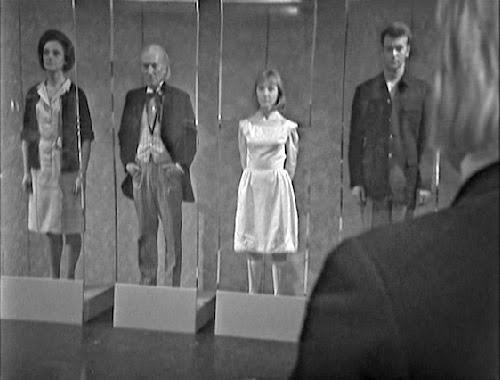Several Doctor Who stories are reminiscent of The Prisoner. Perhaps the most obvious is The Macra Terror, shown in 1967 (the same year as The Prisoner began) and concerning mind control and sinister goings-on beneath the surface of a seemingly holiday camp-like colony.
Predating this by two years is 1965's The Space Museum, one of the second season's less well remembered stories. The plot of this closely parallels the story arc seen in Patrick McGoohan's famous series, as the TARDIS crew are forced into violent revolution to escape their ordained fate.
In the first part of The Space Museum, the Doctor, Ian, Barbara and Vicki jump a "time track", temporarily becoming ghostly mannys to get a glimpse of their future as immobilised, permanent exhibits in the space museum of the Moroks. The remainder of the story sees them try to avert this from coming to pass.
In the episode Living in Harmony, Number 6 gets a taste of what is in store for him when his Sheriff persona is shot dead by the Judge (Number 2) for ultimately refusing to work for him. It seems an obvious reading that the same fate awaits Number 6 if he continues to hold out against the Village authorities indefinitely, unless he escapes or otherwise takes action to prevent this.
Siding with the young Xeron rebels, the TARDIS crew lead a violent uprising, a revolution, against the Morok baddys using their own guns against them. One of the highlights of the story is Vicki in The Search, having reprogrammed the computer guarding the Morok's armoury to open the door to her responding truthfully to its questions:
Computer: "What is your name?"
Vicki: "Vicki."
Computer: "For what purpose are the arms needed?"
Vicki: "Revolution!"
So while it could seem that they act somewhat out of character in this story, with first Ian and later the others turning to guns and violence far more readily than usual, I think it is an attempt - a not wholly successful attempt, more on this later - to show their reactions to the exceptional pressure they are under, and their desperation to escape an awful fate.
In Fall Out, Number 6 is seemingly offered the chance to lead the Village (it may be a genuine offer, but it is likely a trick - this is Fall Out, so everything is open to interpretation) and then sees his own face reflected when he finally meets Number 1 (silly Number 6, don't you know what a mirror is?) and, after that revelation of an alternative destiny for him, he leads fellow prisoners Number 2 and Number 48 in an armed uprising against the Village.
The Space Museum has original, imaginative ideas at its heart, but it is almost the forgotten story of its era because the execution of the production falls short of the concept in every important respect. There are nice moments in each of the four episodes - the TARDIS crew confronting their frozen selves; the Doctor outwitting Lobos's mind-reading machine; Vicki hacking the armoury's computer; and the Doctor recovering from being partially frozen - all good bits, but they cannot save the story as a whole from being less than the sum of these parts.
The guest cast - the Morok baddys and the Xeron rebels - have too little to help them stand out, not helped by all the Moroks dressing and looking alike, and the same goes for the Xerons. The sets of the space museum are uninspiring, drab and grey (I know it is in black and white, but there's grey like Expensive Luxury Cat and then there's grey like John Majors) and these factors seem to sap the energy from the story.
The script may have a solid core concept, and some great individual scenes, but it cannot live up to the full promise of part one because we are never fully sure if the main characters are acting out of character or from the sense of real desperation I argued earlier. Even the magnificent acting of William Russell (purr) does not put this across. The script also falls short in portraying the Moroks and Xerons - the portrayal of the Moroks on screen makes them seem like bored, petty bureaucrats, while the exposition given by Tor and the other Xerons tells us they are supposed to be enslaving tyrants.
The charge of inconsistency could be leveled at The Prisoner also, but it gets away with it by seeking refuge in audacity with the magnificent allegorical ending of Fall Out. Doctor Who has its own rules that it has to work within (most of the time), so does not have this freedom. In the end the best that can be said of both series is that they told their stories using the resources that were available to them at the time.
The Space Museum is far from perfect, but it achieves a synthesis of Doctor Who with the spirit of The Prisoner. If only for a moment, it is wonderful.
"Revolution!"
















No comments:
Post a Comment